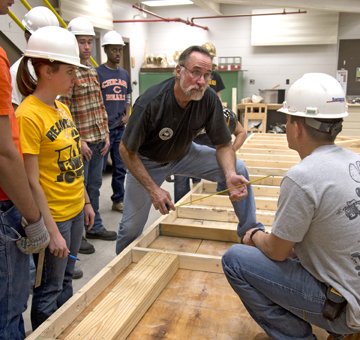Did You Know?: D. Dorsey Moss Construction Lab
September 26, 2013
 |
|
Brian Loss, clinical assistant professor of building construction management technology, talks to students in the D. Dorsey Moss Construction Lab. Located in the basement of Knoy Hall, the lab gives building construction management students the opportunity to assemble hands-on construction projects. (Purdue University photo/Mark Simons) |
Hidden in the basement of Knoy Hall, the D. Dorsey Moss Construction Lab gives building construction management students the opportunity to assemble hands-on construction projects.
When Purdue decided to erect a building for the College of Technology in 1980, faculty and staff began brainstorming ideas for a construction lab that would give students an opportunity to learn what materials and manpower were needed on a construction site. Although the Department of Building Construction Management wanted an open space where it could build large-scale structures, it was forced to settle for a room with a column in the middle. This column, however, provided the means to incorporate the lab's most distinguishing feature: a tower crane.
"At the time, it was the first lab we know of that had a tower crane in it," says Wesley Crawford, professor of building construction management. "The tower crane is the most unique part, and the fact that we build structures inside."
The construction lab was opened in 1984 and later named the D. Dorsey Moss Construction Lab after D. Dorsey Moss, professor of building construction management technology and the first head of the department. Moss was a huge supporter of the lab. His ingenuity helped turn the undesirable column in the lab into the foundation for the tower crane.
The construction lab includes a room for construction, a computer lab, a conference room, a lab to test soils and concrete and storage areas. A mezzanine allows students, faculty and visitors to safely observe construction projects going on in the lab below. The entire construction lab lacks a finished ceiling, allowing all plumbing, electrical wiring, and ventilation systems to be exposed. The unfinished ceiling is designed to show students how these systems are included in a structure. To avoid disrupting surrounding classrooms when students are working on construction projects, the lab is also equipped with sound panels on the walls and ceiling.
Students in Construction Materials and Methods, a class for freshmen, build one wooden structure, one steel structure, one concrete structure and one masonry structure as well as concrete walls in the construction lab. Students use the tower crane when lifting structural steel and formwork for the concrete building. After the structures are assembled, students deconstruct and build the next structure. Although some new materials are bought annually, nearly all materials are recycled and used the following year.
"We want the students to know the materials, manpower, money, machines and time that goes into building structures," Crawford says. The students need to know that you can't build unless you learn to manage these items. The mission of our program is to produce the finest construction managers in the country."
Doug Keith, assistant clinical professor of building construction management, says students need to have an idea of how buildings are assembled before going into the workforce.
"We feel they can't learn to schedule work activities if they don't know what the difficulty is in putting something together and what it takes to assemble a building," he says.
For more information on the D. Dorsey Moss Construction Lab, visit https://tech.purdue.edu/facilities/d-dorsey-moss-construction-lab.
Writer: Hannah Harper, harper4@purdue.edu

